
Go语言的并发模型基于CSP(Communicating Sequential Processes)理论。Go的并发哲学强调:
“Do not communicate by sharing memory; instead, share memory by communicating."
goroutine和channel是Go语言CSP并发模型的两大核心概念,本文将从源码层面对channel进行深度解析。

版本说明
本文涉及到的源码解析部分来源于go官方的1.16.5版本,其中英文部分的注释也属于源码,中文部分的注释则属于笔者添加。
channel的定义
channel是Go语言的内置数据类型,以chan关键字作为Go语言的语法之一。要从源码角度解析channel,我们需要查看channel在runtime层面的定义:
// go/src/runtime/chan.go
type hchan struct {
qcount uint // total data in the queue
dataqsiz uint // size of the circular queue
buf unsafe.Pointer // points to an array of dataqsiz elements
elemsize uint16
closed uint32
elemtype *_type // element type
sendx uint // send index
recvx uint // receive index
recvq waitq // list of recv waiters
sendq waitq // list of send waiters
// lock protects all fields in hchan, as well as several
// fields in sudogs blocked on this channel.
//
// Do not change another G's status while holding this lock
// (in particular, do not ready a G), as this can deadlock
// with stack shrinking.
lock mutex
}
channel的结构主要由以下几个部分组成:
- 环形队列缓存:当channel缓冲区未满且仍有send请求的时候,该队列将用于缓存此时收到的消息。
- 双向链表:当channel缓冲区已满且仍有send请求或者已空但仍有recv请求的时候,channel将进入阻塞状态。通过该双向链表存放阻塞的Goroutine信息,以sudog的形式包裹G。
- 锁:go语言的channel基于悲观锁实现。
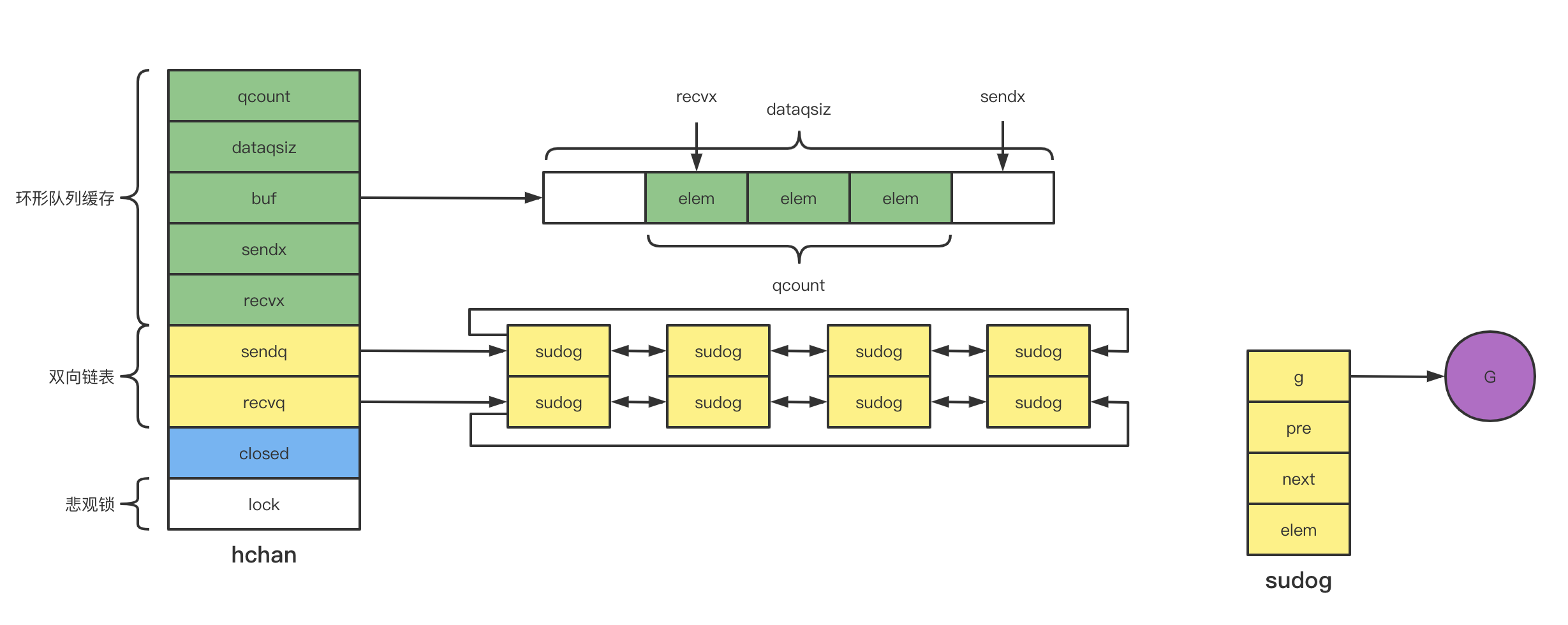
如图所示,channel结构体的含义如下:
qcount:环形队列缓存的实际大小,即当前缓存的消息个数。dataqsiz:环形队列缓存的容量,即允许缓存的消息最大个数。buf:环形队列缓存的具体数据。sendx:环形队列缓存的指针之一。recvx:环形队列缓存的指针之一。sendq:当缓冲区已满且仍有send请求,send方将会阻塞,该双向链表存放阻塞sudog。recvq:当缓冲区已空且仍有recv请求,recv方将会阻塞,该双向链表存放阻塞sudog。closed:是否已经关闭。lock:悲观锁。
channel的创建
我们可以通过make函数创建chan,分为不带缓冲和带缓冲两种:
package main
import "fmt"
func main() {
ch1 := make(chan struct{}) // 不带缓冲
ch2 := make(chan struct{}, 10) // 带缓冲
fmt.Println(len(ch1), len(ch2))
}
不带缓冲和带缓冲的本质区别其实就在于底层的环形队列缓存。对于带缓冲的情况而言,消息可以被暂时存放进队列缓存中,不会导致发送方的G直接进入阻塞状态。
让我们通过go的官方工具来查看汇编结果:
$ go tool compile -S main.go
"".main STEXT size=310 args=0x0 locals=0x80 funcid=0x0
0x0000 00000 (main.go:5) TEXT "".main(SB), ABIInternal, $128-0
0x0000 00000 (main.go:5) MOVQ (TLS), CX
0x0009 00009 (main.go:5) CMPQ SP, 16(CX)
0x000d 00013 (main.go:5) PCDATA $0, $-2
0x000d 00013 (main.go:5) JLS 300
0x0013 00019 (main.go:5) PCDATA $0, $-1
0x0013 00019 (main.go:5) ADDQ $-128, SP
0x0017 00023 (main.go:5) MOVQ BP, 120(SP)
0x001c 00028 (main.go:5) LEAQ 120(SP), BP
0x0021 00033 (main.go:5) FUNCDATA $0, gclocals·7d2d5fca80364273fb07d5820a76fef4(SB)
0x0021 00033 (main.go:5) FUNCDATA $1, gclocals·729b7dbc411005893d6fd941e5c100f6(SB)
0x0021 00033 (main.go:5) FUNCDATA $2, "".main.stkobj(SB)
0x0021 00033 (main.go:6) LEAQ type.chan struct {}(SB), AX
0x0028 00040 (main.go:6) MOVQ AX, (SP)
0x002c 00044 (main.go:6) MOVQ $0, 8(SP)
0x0035 00053 (main.go:6) PCDATA $1, $0
0x0035 00053 (main.go:6) CALL runtime.makechan(SB) # 创建不带缓冲的channel
0x003a 00058 (main.go:6) MOVQ 16(SP), AX
0x003f 00063 (main.go:6) MOVQ AX, "".ch1+72(SP)
0x0044 00068 (main.go:7) LEAQ type.chan struct {}(SB), CX
0x004b 00075 (main.go:7) MOVQ CX, (SP)
0x004f 00079 (main.go:7) MOVQ $10, 8(SP)
0x0058 00088 (main.go:7) PCDATA $1, $1
0x0058 00088 (main.go:7) CALL runtime.makechan(SB) # 创建带缓冲的channel
0x005d 00093 (main.go:7) MOVQ 16(SP), AX
0x0062 00098 (main.go:8) MOVQ "".ch1+72(SP), CX
0x0067 00103 (main.go:8) TESTQ CX, CX
0x006a 00106 (main.go:8) JEQ 293
0x0070 00112 (main.go:8) MOVQ (CX), CX
0x0073 00115 (main.go:8) TESTQ AX, AX
0x0076 00118 (main.go:8) JEQ 281
0x007c 00124 (main.go:8) MOVQ (AX), AX
0x007f 00127 (main.go:8) MOVQ AX, ""..autotmp_26+64(SP)
0x0084 00132 (main.go:8) MOVQ CX, (SP)
0x0088 00136 (main.go:8) PCDATA $1, $0
0x0088 00136 (main.go:8) CALL runtime.convT64(SB)
0x008d 00141 (main.go:8) MOVQ 8(SP), AX
0x0092 00146 (main.go:8) MOVQ AX, ""..autotmp_27+80(SP)
0x0097 00151 (main.go:8) MOVQ ""..autotmp_26+64(SP), CX
0x009c 00156 (main.go:8) MOVQ CX, (SP)
0x00a0 00160 (main.go:8) PCDATA $1, $2
0x00a0 00160 (main.go:8) CALL runtime.convT64(SB)
0x00a5 00165 (main.go:8) MOVQ 8(SP), AX
0x00aa 00170 (main.go:8) XORPS X0, X0
0x00ad 00173 (main.go:8) MOVUPS X0, ""..autotmp_18+88(SP)
0x00b2 00178 (main.go:8) MOVUPS X0, ""..autotmp_18+104(SP)
0x00b7 00183 (main.go:8) LEAQ type.int(SB), CX
0x00be 00190 (main.go:8) MOVQ CX, ""..autotmp_18+88(SP)
0x00c3 00195 (main.go:8) MOVQ ""..autotmp_27+80(SP), DX
0x00c8 00200 (main.go:8) MOVQ DX, ""..autotmp_18+96(SP)
0x00cd 00205 (main.go:8) MOVQ CX, ""..autotmp_18+104(SP)
0x00d2 00210 (main.go:8) MOVQ AX, ""..autotmp_18+112(SP)
... 省略不相关的部分
从汇编结果来看,无论是带缓冲还是不带缓冲,channel的创建底层实现都是基于runtime.makechan函数。让我们进一步翻阅相关源码:
func makechan(t *chantype, size int) *hchan {
elem := t.elem
// compiler checks this but be safe.
// 算术溢出判断
if elem.size >= 1<<16 {
throw("makechan: invalid channel element type")
}
if hchanSize%maxAlign != 0 || elem.align > maxAlign {
throw("makechan: bad alignment")
}
mem, overflow := math.MulUintptr(elem.size, uintptr(size))
if overflow || mem > maxAlloc-hchanSize || size < 0 {
panic(plainError("makechan: size out of range"))
}
// Hchan does not contain pointers interesting for GC when elements stored in buf do not contain pointers.
// buf points into the same allocation, elemtype is persistent.
// SudoG's are referenced from their owning thread so they can't be collected.
// TODO(dvyukov,rlh): Rethink when collector can move allocated objects.
// 根据不同情况来分配内存:
// 1. 不带缓冲:只给hchan分配内存
// 2. 带缓冲且不包括指针类型:给hchan和环形队列缓存分配一段连续的内存空间
// 3. 带缓冲且包括指针类型:给hchan和环形队列缓存分别分配内存空间
var c *hchan
switch {
case mem == 0:
// Queue or element size is zero.
c = (*hchan)(mallocgc(hchanSize, nil, true))
// Race detector uses this location for synchronization.
c.buf = c.raceaddr()
case elem.ptrdata == 0:
// Elements do not contain pointers.
// Allocate hchan and buf in one call.
c = (*hchan)(mallocgc(hchanSize+mem, nil, true))
c.buf = add(unsafe.Pointer(c), hchanSize)
default:
// Elements contain pointers.
c = new(hchan)
c.buf = mallocgc(mem, elem, true)
}
// 更新以下字段的值
c.elemsize = uint16(elem.size)
c.elemtype = elem
c.dataqsiz = uint(size)
lockInit(&c.lock, lockRankHchan)
if debugChan {
print("makechan: chan=", c, "; elemsize=", elem.size, "; dataqsiz=", size, "\n")
}
return c
}
runtime.makechan为新创建的channel分配内存空间,考虑三种情况:
- 不带缓冲区:只需要给
hchan分配内存空间。 - 带缓冲区且不包括指针类型:同时给
hchan和环形队列缓存buf分配一段连续的内存空间。 - 带缓冲区且包括指针类型:分别给
hchan和环形队列缓存buf分配不同的内存空间。
channel的发送和接收
基本原则
channel的核心作用在于为不同的goroutine传输数据,因此首先要声明强调的是:channel的发送和接收必须位于不同的goroutine内,在相同的goroutine内同时给channel发送和接收数据则会引发死锁问题:
package main
func main() {
ch := make(chan struct{})
ch <- struct{}{}
<-ch
}
$ go run main.go
fatal error: all goroutines are asleep - deadlock!
goroutine 1 [chan send]:
main.main()
/root/go/src/gogogo/main.go:6 +0x53
exit status 2
三种情况
channel的发送和接收主要考虑三种情况:
- 移动缓冲区
- 阻塞
- 缓冲区复制 && 直接发送
第一种情况:移动缓冲区
当channel缓冲区 未满 的时候,底层环形队列缓存将会保存消息,此时发送方和接收方都从队列缓存中直接操作消息。
当channel新增发送方,
hchan首先会加锁,其次将发送方的消息体存放进sendx,接着移动sendx指针,最后释放锁。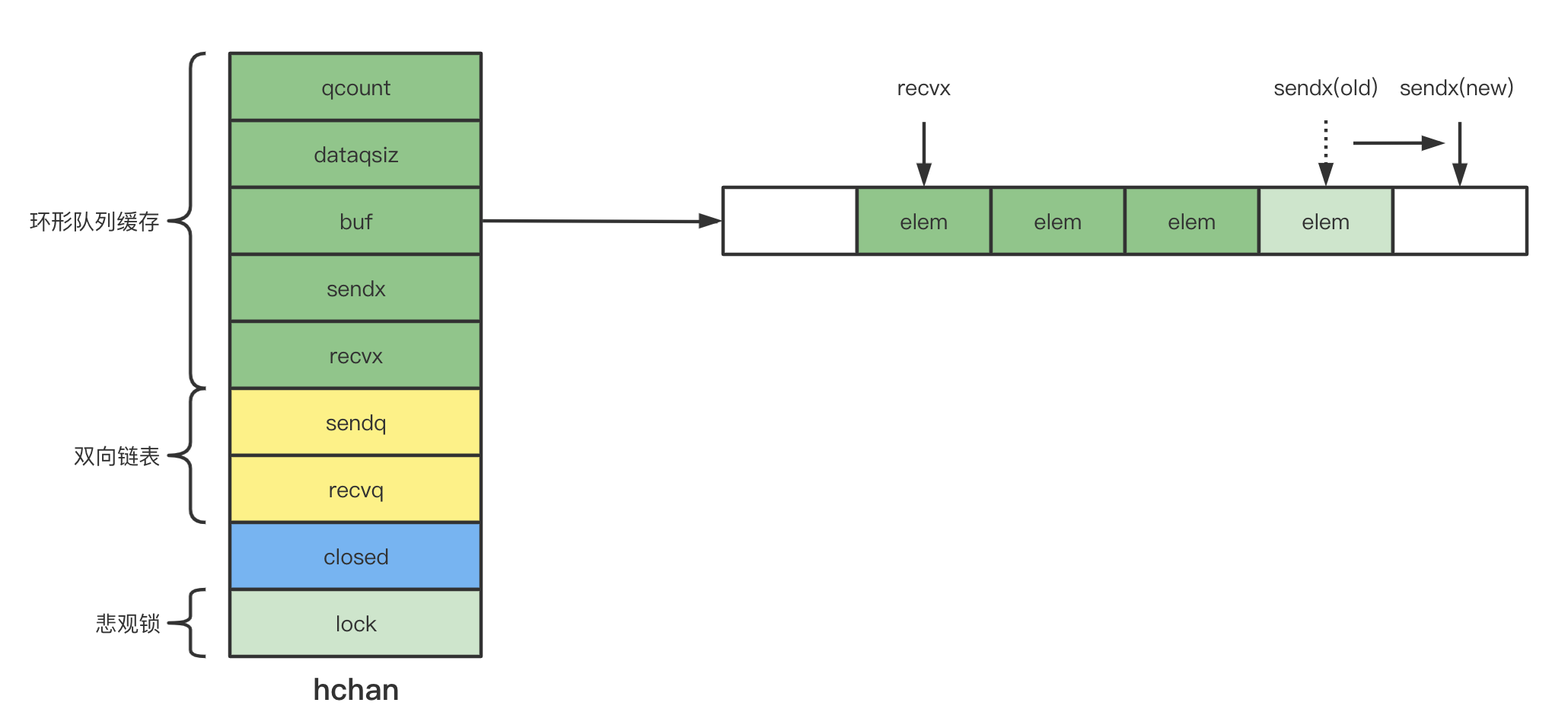
channel新增发送方 当channel新增接收方,
hchan首先会加锁,其次将recvx的消息体取出,接着移动recvx指针,最后释放锁。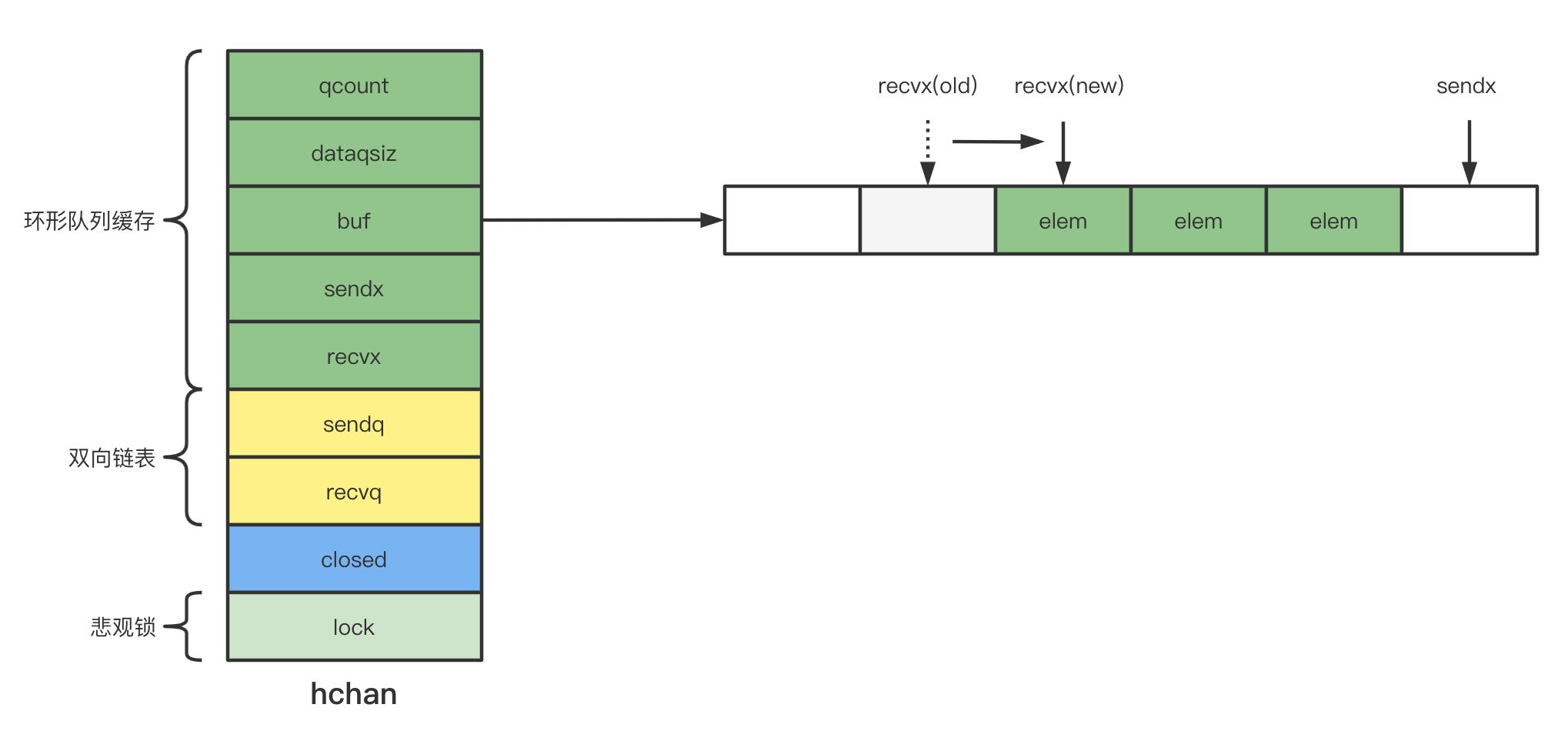
channel新增接收方
第二种情况:阻塞
当channel缓冲区 已满且仍有发送方 或者 已空且仍有接收方 的时候,此时新增的发送方G/接收方G将进入阻塞状态。此时,阻塞的G将被包装进sudog结构体中,并以双向链表的形式保存下来。
当channel缓冲区已满且仍有发送方,新增的发送方G将进入阻塞状态,以sudog的形式加入
sendq中。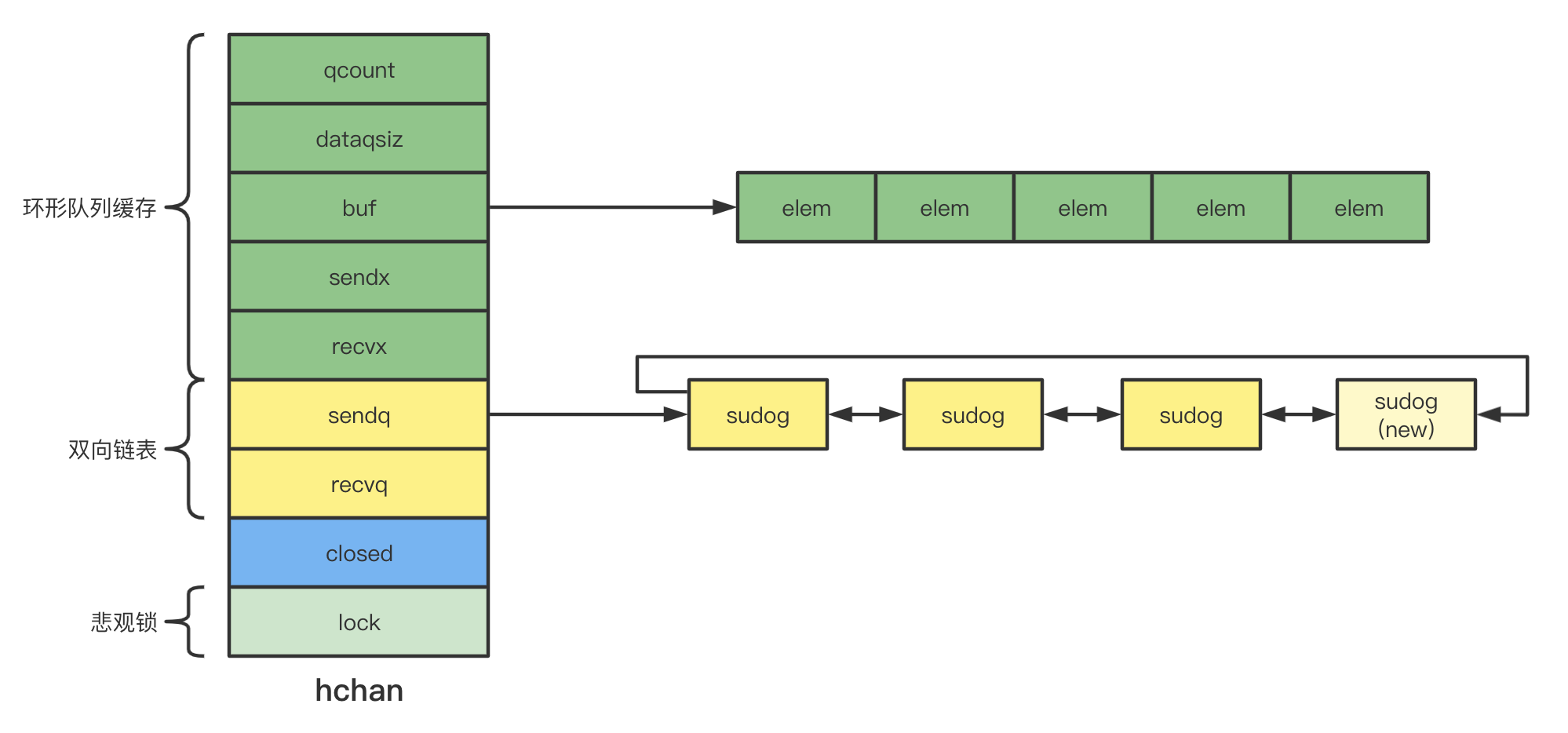
channel缓冲区已满,新增发送方 当channel缓冲区已空且仍有接收方,新增的接收方G将进入阻塞状态,以sudog的形式加入
recvq中。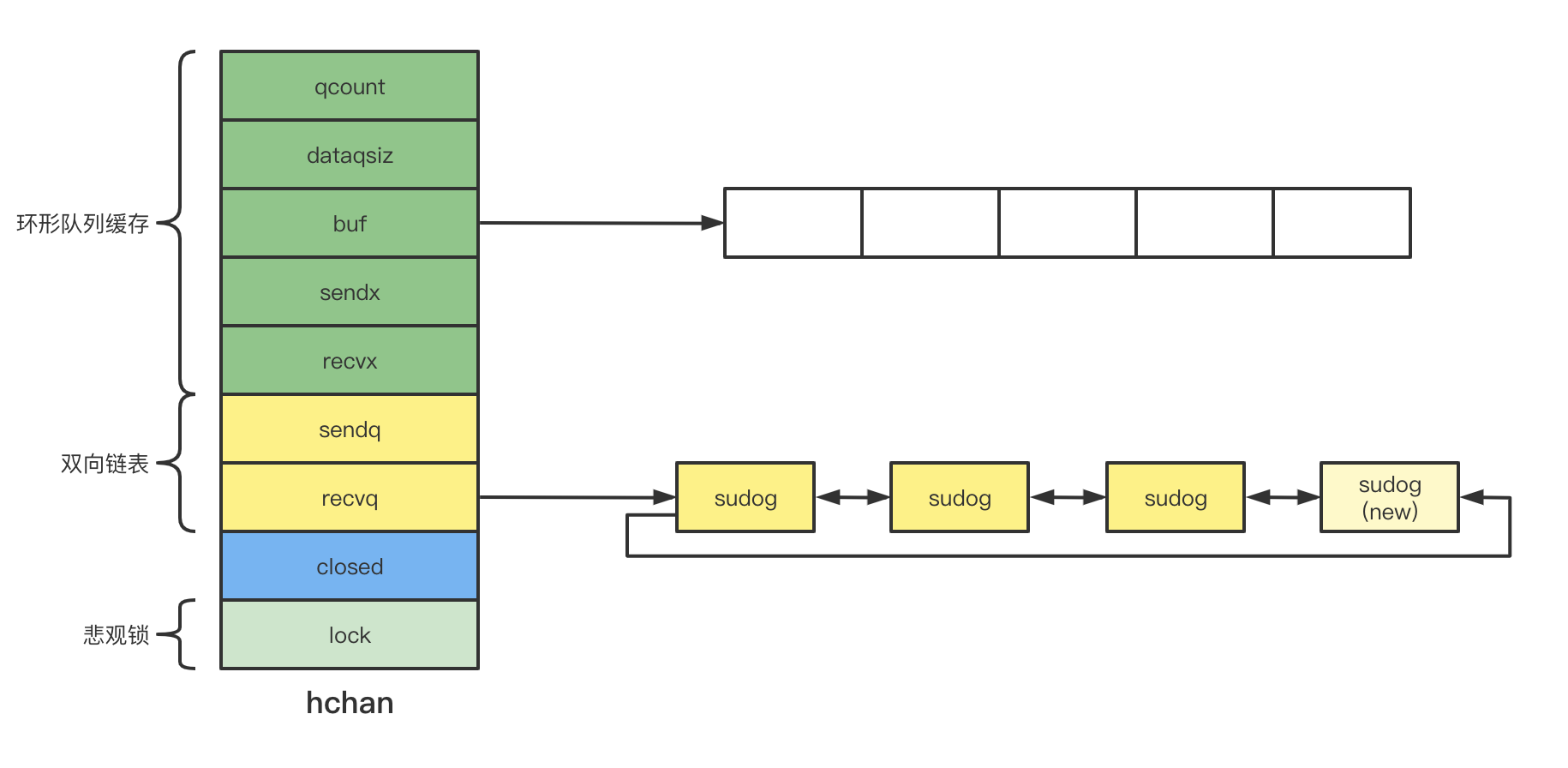
channel缓冲区已空,新增接收方
第三种情况:缓冲区复制 && 直接发送
在上述第二种情况的基础上,当channel 存在阻塞发送方且新增了接收方 的时候,channel会将缓冲区的数据返回给接收方,同时将阻塞在双向链表队头的发送方唤醒,并将其消息复制进缓冲区。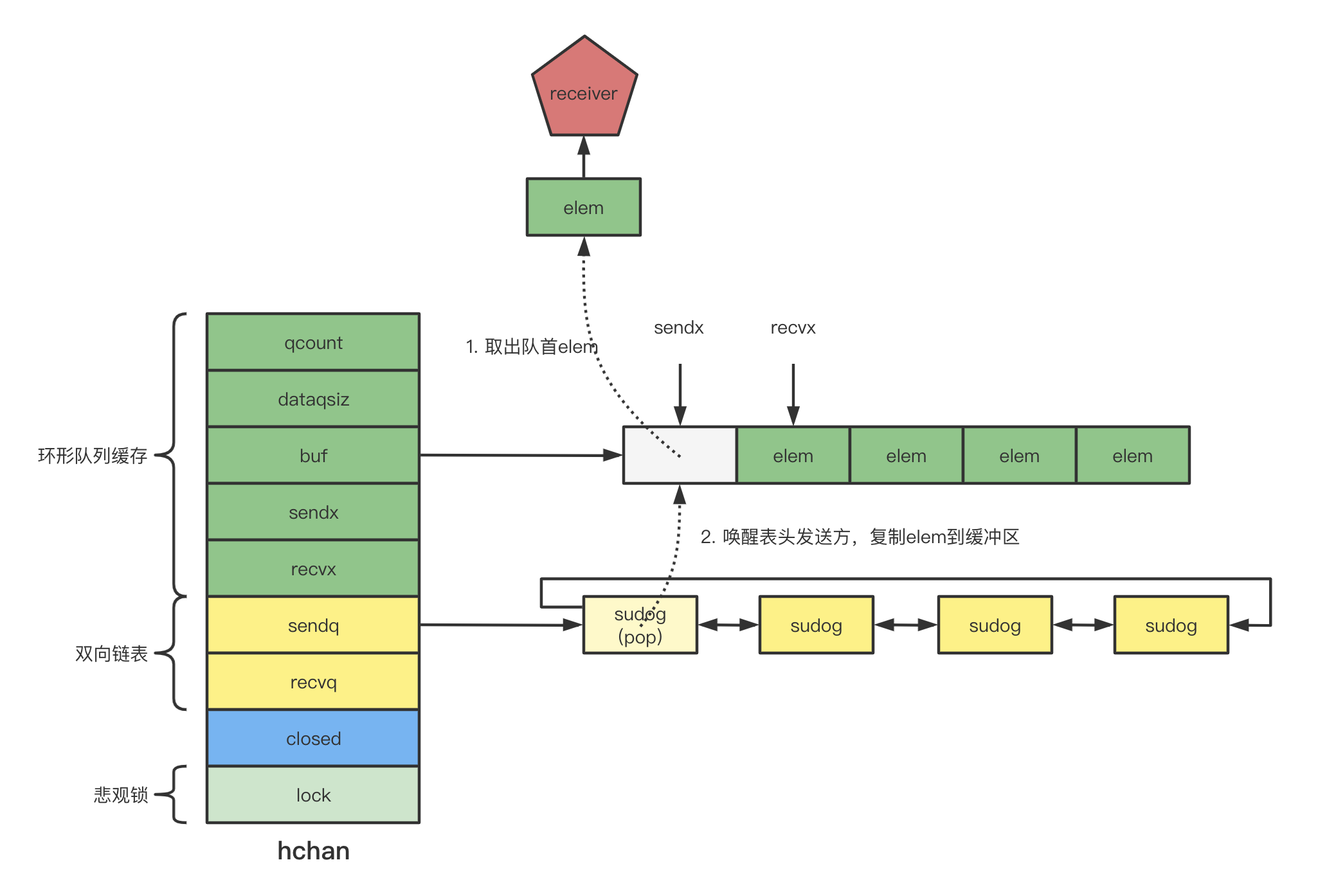
当channel 存在阻塞接收方且新增了发送方 的时候,channel会唤醒阻塞的接收方,然后直接把数据从发送方复制到接收方,无需再经过缓冲区,即直接发送。
源码分析
接下来,我们通过源码的方式进一步分析channel的发送和接收。
package main
func main() {
ch := make(chan struct{})
go func() {
ch <- struct{}{}
}()
<-ch
}
"".main STEXT size=133 args=0x0 locals=0x28 funcid=0x0
0x0000 00000 (main.go:3) TEXT "".main(SB), ABIInternal, $40-0
0x0000 00000 (main.go:3) MOVQ (TLS), CX
0x0009 00009 (main.go:3) CMPQ SP, 16(CX)
0x000d 00013 (main.go:3) PCDATA $0, $-2
0x000d 00013 (main.go:3) JLS 121
0x000f 00015 (main.go:3) PCDATA $0, $-1
0x000f 00015 (main.go:3) SUBQ $40, SP
0x0013 00019 (main.go:3) MOVQ BP, 32(SP)
0x0018 00024 (main.go:3) LEAQ 32(SP), BP
0x001d 00029 (main.go:3) FUNCDATA $0, gclocals·69c1753bd5f81501d95132d08af04464(SB)
0x001d 00029 (main.go:3) FUNCDATA $1, gclocals·9fb7f0986f647f17cb53dda1484e0f7a(SB)
0x001d 00029 (main.go:4) LEAQ type.chan struct {}(SB), AX
0x0024 00036 (main.go:4) MOVQ AX, (SP)
0x0028 00040 (main.go:4) MOVQ $0, 8(SP)
0x0031 00049 (main.go:4) PCDATA $1, $0
0x0031 00049 (main.go:4) CALL runtime.makechan(SB)
0x0036 00054 (main.go:4) MOVQ 16(SP), AX
0x003b 00059 (main.go:4) MOVQ AX, "".ch+24(SP)
0x0040 00064 (main.go:6) MOVL $8, (SP)
0x0047 00071 (main.go:6) LEAQ "".main.func1·f(SB), CX
0x004e 00078 (main.go:6) MOVQ CX, 8(SP)
0x0053 00083 (main.go:6) PCDATA $1, $1
0x0053 00083 (main.go:6) CALL runtime.newproc(SB)
0x0058 00088 (main.go:10) MOVQ "".ch+24(SP), AX
0x005d 00093 (main.go:10) MOVQ AX, (SP)
0x0061 00097 (main.go:10) MOVQ $0, 8(SP)
0x006a 00106 (main.go:10) PCDATA $1, $0
0x006a 00106 (main.go:10) CALL runtime.chanrecv1(SB) # channel接收
0x006f 00111 (main.go:11) MOVQ 32(SP), BP
0x0074 00116 (main.go:11) ADDQ $40, SP
0x0078 00120 (main.go:11) RET
0x0079 00121 (main.go:11) NOP
0x0079 00121 (main.go:3) PCDATA $1, $-1
0x0079 00121 (main.go:3) PCDATA $0, $-2
0x0079 00121 (main.go:3) CALL runtime.morestack_noctxt(SB)
0x007e 00126 (main.go:3) PCDATA $0, $-1
0x007e 00126 (main.go:3) NOP
0x0080 00128 (main.go:3) JMP 0
... 省略不相关的部分
"".main.func1 STEXT size=71 args=0x8 locals=0x18 funcid=0x0
0x0000 00000 (main.go:6) TEXT "".main.func1(SB), ABIInternal, $24-8
0x0000 00000 (main.go:6) MOVQ (TLS), CX
0x0009 00009 (main.go:6) CMPQ SP, 16(CX)
0x000d 00013 (main.go:6) PCDATA $0, $-2
0x000d 00013 (main.go:6) JLS 64
0x000f 00015 (main.go:6) PCDATA $0, $-1
0x000f 00015 (main.go:6) SUBQ $24, SP
0x0013 00019 (main.go:6) MOVQ BP, 16(SP)
0x0018 00024 (main.go:6) LEAQ 16(SP), BP
0x001d 00029 (main.go:6) FUNCDATA $0, gclocals·1a65e721a2ccc325b382662e7ffee780(SB)
0x001d 00029 (main.go:6) FUNCDATA $1, gclocals·69c1753bd5f81501d95132d08af04464(SB)
0x001d 00029 (main.go:7) MOVQ "".ch+32(SP), AX
0x0022 00034 (main.go:7) MOVQ AX, (SP)
0x0026 00038 (main.go:7) LEAQ ""..autotmp_1+16(SP), AX
0x002b 00043 (main.go:7) MOVQ AX, 8(SP)
0x0030 00048 (main.go:7) PCDATA $1, $1
0x0030 00048 (main.go:7) CALL runtime.chansend1(SB) # channel发送
0x0035 00053 (main.go:8) MOVQ 16(SP), BP
0x003a 00058 (main.go:8) ADDQ $24, SP
0x003e 00062 (main.go:8) RET
0x003f 00063 (main.go:8) NOP
0x003f 00063 (main.go:6) PCDATA $1, $-1
0x003f 00063 (main.go:6) PCDATA $0, $-2
0x003f 00063 (main.go:6) NOP
0x0040 00064 (main.go:6) CALL runtime.morestack_noctxt(SB)
0x0045 00069 (main.go:6) PCDATA $0, $-1
0x0045 00069 (main.go:6) JMP 0
... 省略不相关的部分
从汇编结果来看,channel的发送底层实现是runtime.chansend1函数,channel的接收底层实现是runtime.chanrecv1函数。我们进一步查看相关源码:
func chansend1(c *hchan, elem unsafe.Pointer) {
chansend(c, elem, true, getcallerpc())
}
func chanrecv1(c *hchan, elem unsafe.Pointer) {
chanrecv(c, elem, true)
}
func chanrecv2(c *hchan, elem unsafe.Pointer) (received bool) {
_, received = chanrecv(c, elem, true)
return
}
值得注意的是,runtime源码中包括2个recv函数:runtime.chanrecv1和runtime.chanrecv2。从实现上面可以看出,runtime.chanrecv2是用于接收方返回两个参数的场景。
发送
我们先来解析runtime.chansend的源码部分(PS:由于源码分析比较复杂,因此主要阐述其中的关键环节):
func chansend(c *hchan, ep unsafe.Pointer, block bool, callerpc uintptr) bool {
... 省略不相关的部分
// 直接发送:当存在阻塞的接收方,且新增了发送方,那么直接把发送方的消息复制给接收方
if sg := c.recvq.dequeue(); sg != nil {
// Found a waiting receiver. We pass the value we want to send
// directly to the receiver, bypassing the channel buffer (if any).
send(c, sg, ep, func() { unlock(&c.lock) }, 3)
return true
}
// 缓冲区:当缓冲区未满,那么通过移动环形队列缓存的指针来存储消息
if c.qcount < c.dataqsiz {
// Space is available in the channel buffer. Enqueue the element to send.
qp := chanbuf(c, c.sendx)
if raceenabled {
racenotify(c, c.sendx, nil)
}
typedmemmove(c.elemtype, qp, ep)
c.sendx++ // 移动指针
if c.sendx == c.dataqsiz {
c.sendx = 0
}
c.qcount++
unlock(&c.lock)
return true
}
if !block {
unlock(&c.lock)
return false
}
// Block on the channel. Some receiver will complete our operation for us.
// 阻塞:当缓冲区已满,此时当前的发送方需要进入阻塞状态。
gp := getg()
mysg := acquireSudog()
mysg.releasetime = 0
if t0 != 0 {
mysg.releasetime = -1
}
// No stack splits between assigning elem and enqueuing mysg
// on gp.waiting where copystack can find it.
mysg.elem = ep
mysg.waitlink = nil
mysg.g = gp
mysg.isSelect = false
mysg.c = c
gp.waiting = mysg
gp.param = nil
c.sendq.enqueue(mysg)
// Signal to anyone trying to shrink our stack that we're about
// to park on a channel. The window between when this G's status
// changes and when we set gp.activeStackChans is not safe for
// stack shrinking.
atomic.Store8(&gp.parkingOnChan, 1)
gopark(chanparkcommit, unsafe.Pointer(&c.lock), waitReasonChanSend, traceEvGoBlockSend, 2) // 将goroutine阻塞
// Ensure the value being sent is kept alive until the
// receiver copies it out. The sudog has a pointer to the
// stack object, but sudogs aren't considered as roots of the
// stack tracer.
KeepAlive(ep)
... 省略不相关的部分
}
接收
最后我们来解析runtime.chanrecv源码部分:
func chanrecv(c *hchan, ep unsafe.Pointer, block bool) (selected, received bool) {
... 省略不相关的部分
// 缓冲区复制:当存在阻塞的发送方,会从缓冲区读取消息,并且唤醒发送方将消息放入缓冲区。这里面同时存在一个临界状态,即当缓冲区长度是0的时候,则会将发送方的消息直接复制到接收方
if sg := c.sendq.dequeue(); sg != nil {
// Found a waiting sender. If buffer is size 0, receive value
// directly from sender. Otherwise, receive from head of queue
// and add sender's value to the tail of the queue (both map to
// the same buffer slot because the queue is full).
recv(c, sg, ep, func() { unlock(&c.lock) }, 3)
return true, true
}
// 缓冲区:当缓冲区未空的时候,那么通过移动环形队列缓存的指针来发送消息
if c.qcount > 0 {
// Receive directly from queue
qp := chanbuf(c, c.recvx)
if raceenabled {
racenotify(c, c.recvx, nil)
}
if ep != nil {
typedmemmove(c.elemtype, ep, qp)
}
typedmemclr(c.elemtype, qp)
c.recvx++ // 移动指针
if c.recvx == c.dataqsiz {
c.recvx = 0
}
c.qcount--
unlock(&c.lock)
return true, true
}
if !block {
unlock(&c.lock)
return false, false
}
// no sender available: block on this channel.
// 阻塞:当缓冲区已空,那么需要阻塞当前的接收方
gp := getg()
mysg := acquireSudog()
mysg.releasetime = 0
if t0 != 0 {
mysg.releasetime = -1
}
// No stack splits between assigning elem and enqueuing mysg
// on gp.waiting where copystack can find it.
mysg.elem = ep
mysg.waitlink = nil
gp.waiting = mysg
mysg.g = gp
mysg.isSelect = false
mysg.c = c
gp.param = nil
c.recvq.enqueue(mysg)
// Signal to anyone trying to shrink our stack that we're about
// to park on a channel. The window between when this G's status
// changes and when we set gp.activeStackChans is not safe for
// stack shrinking.
atomic.Store8(&gp.parkingOnChan, 1)
gopark(chanparkcommit, unsafe.Pointer(&c.lock), waitReasonChanReceive, traceEvGoBlockRecv, 2) // 将goroutine阻塞
... 省略不相关的部分
}
对照一下runtime.recv源码实现:
func recv(c *hchan, sg *sudog, ep unsafe.Pointer, unlockf func(), skip int) {
if c.dataqsiz == 0 { // 缓冲区为0的情况,直接复制
if raceenabled {
racesync(c, sg)
}
if ep != nil {
// copy data from sender
recvDirect(c.elemtype, sg, ep)
}
} else {
// 缓冲区不为0的情况,需要从缓冲区去发送消息,并且把阻塞队列队头的发送方唤醒
// Queue is full. Take the item at the
// head of the queue. Make the sender enqueue
// its item at the tail of the queue. Since the
// queue is full, those are both the same slot.
qp := chanbuf(c, c.recvx)
if raceenabled {
racenotify(c, c.recvx, nil)
racenotify(c, c.recvx, sg)
}
// copy data from queue to receiver
if ep != nil {
typedmemmove(c.elemtype, ep, qp)
}
// copy data from sender to queue
typedmemmove(c.elemtype, qp, sg.elem)
c.recvx++
if c.recvx == c.dataqsiz {
c.recvx = 0
}
c.sendx = c.recvx // c.sendx = (c.sendx+1) % c.dataqsiz
}
sg.elem = nil
gp := sg.g
unlockf()
gp.param = unsafe.Pointer(sg)
sg.success = true
if sg.releasetime != 0 {
sg.releasetime = cputicks()
}
goready(gp, skip+1)
}
channel的关闭
channel的关闭并不复杂。但由于channel本身是悲观锁实现,因此channel在关闭的时候,为了减少悲观锁的占用时间,channel会创建一个glist队列,将当前仍然阻塞的sendq和recvq上面的sudog加入glist,然后快速释放掉锁。紧接着,channel会将glist上面阻塞的goroutine以此唤醒。
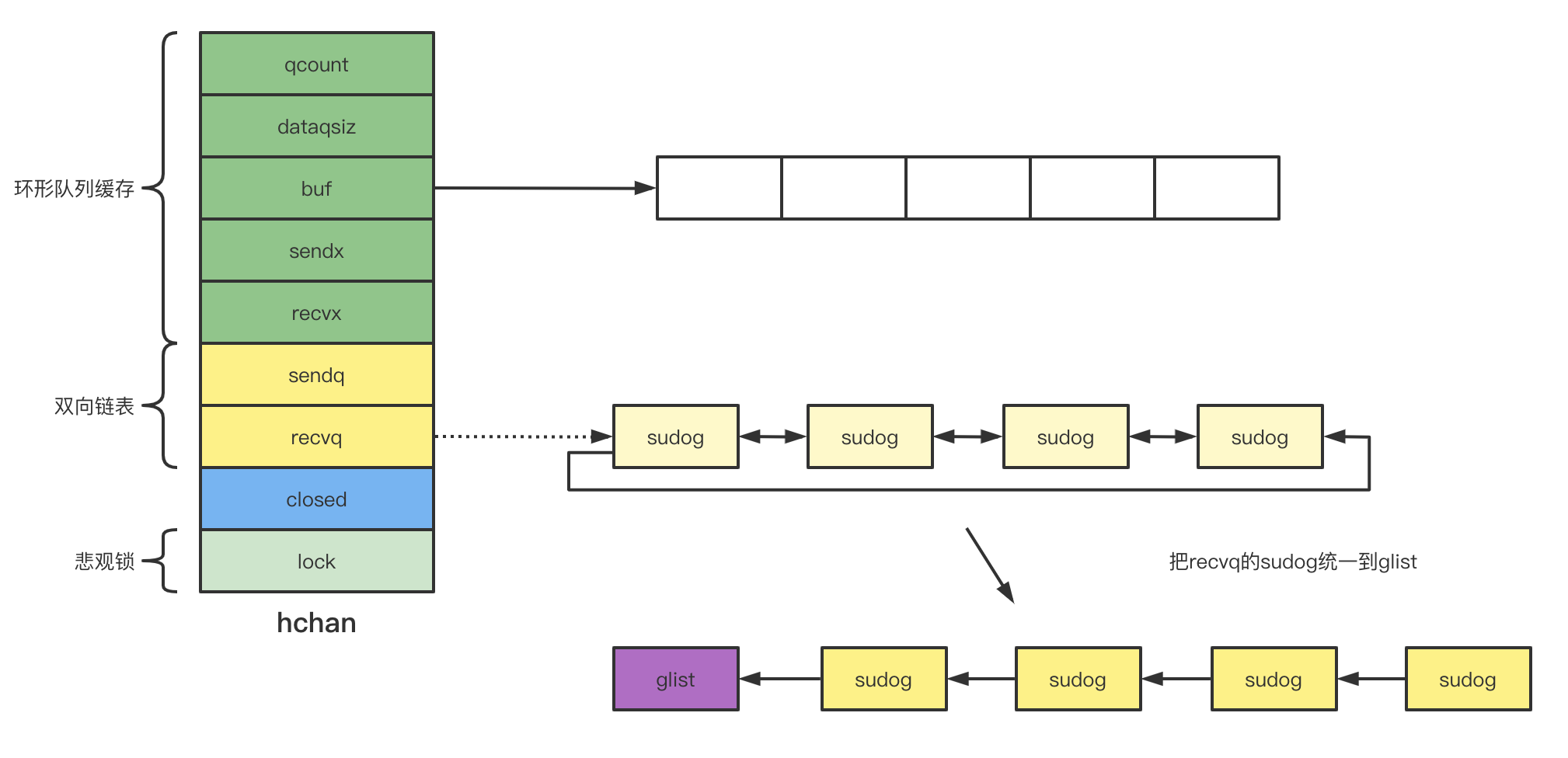
我们进一步分析channel的源码实现:
package main
func main() {
ch := make(chan struct{})
go func() {
ch <- struct{}{}
close(ch)
}()
<-ch
}
$ go tool compile -S main.go
"".main.func1 STEXT size=86 args=0x8 locals=0x18 funcid=0x0
0x0000 00000 (main.go:6) TEXT "".main.func1(SB), ABIInternal, $24-8
0x0000 00000 (main.go:6) MOVQ (TLS), CX
0x0009 00009 (main.go:6) CMPQ SP, 16(CX)
0x000d 00013 (main.go:6) PCDATA $0, $-2
0x000d 00013 (main.go:6) JLS 79
0x000f 00015 (main.go:6) PCDATA $0, $-1
0x000f 00015 (main.go:6) SUBQ $24, SP
0x0013 00019 (main.go:6) MOVQ BP, 16(SP)
0x0018 00024 (main.go:6) LEAQ 16(SP), BP
0x001d 00029 (main.go:6) FUNCDATA $0, gclocals·1a65e721a2ccc325b382662e7ffee780(SB)
0x001d 00029 (main.go:6) FUNCDATA $1, gclocals·69c1753bd5f81501d95132d08af04464(SB)
0x001d 00029 (main.go:7) MOVQ "".ch+32(SP), AX
0x0022 00034 (main.go:7) MOVQ AX, (SP)
0x0026 00038 (main.go:7) LEAQ ""..autotmp_1+16(SP), CX
0x002b 00043 (main.go:7) MOVQ CX, 8(SP)
0x0030 00048 (main.go:7) PCDATA $1, $0
0x0030 00048 (main.go:7) CALL runtime.chansend1(SB)
0x0035 00053 (main.go:9) MOVQ "".ch+32(SP), AX
0x003a 00058 (main.go:9) MOVQ AX, (SP)
0x003e 00062 (main.go:9) PCDATA $1, $1
0x003e 00062 (main.go:9) NOP
0x0040 00064 (main.go:9) CALL runtime.closechan(SB) # 关闭channel
0x0045 00069 (main.go:10) MOVQ 16(SP), BP
0x004a 00074 (main.go:10) ADDQ $24, SP
0x004e 00078 (main.go:10) RET
0x004f 00079 (main.go:10) NOP
0x004f 00079 (main.go:6) PCDATA $1, $-1
0x004f 00079 (main.go:6) PCDATA $0, $-2
0x004f 00079 (main.go:6) CALL runtime.morestack_noctxt(SB)
0x0054 00084 (main.go:6) PCDATA $0, $-1
0x0054 00084 (main.go:6) JMP 0
... 省略不相关的部分
从汇编的结果可以看出,channel的关闭底层实现是runtime.closechan,让我们进一步查看相关源码:
func closechan(c *hchan) {
if c == nil {
panic(plainError("close of nil channel"))
}
lock(&c.lock)
if c.closed != 0 {
unlock(&c.lock)
panic(plainError("close of closed channel"))
}
if raceenabled {
callerpc := getcallerpc()
racewritepc(c.raceaddr(), callerpc, funcPC(closechan))
racerelease(c.raceaddr())
}
c.closed = 1
var glist gList // 新建glist,是一个队列结构
// release all readers
// 把所有仍然阻塞的接收方加入glist
for {
sg := c.recvq.dequeue()
if sg == nil {
break
}
if sg.elem != nil {
typedmemclr(c.elemtype, sg.elem)
sg.elem = nil
}
if sg.releasetime != 0 {
sg.releasetime = cputicks()
}
gp := sg.g
gp.param = unsafe.Pointer(sg)
sg.success = false
if raceenabled {
raceacquireg(gp, c.raceaddr())
}
glist.push(gp)
}
// release all writers (they will panic)
// 把所有仍然阻塞的发送方加入glist
for {
sg := c.sendq.dequeue()
if sg == nil {
break
}
sg.elem = nil
if sg.releasetime != 0 {
sg.releasetime = cputicks()
}
gp := sg.g
gp.param = unsafe.Pointer(sg)
sg.success = false
if raceenabled {
raceacquireg(gp, c.raceaddr())
}
glist.push(gp)
}
unlock(&c.lock)
// Ready all Gs now that we've dropped the channel lock.
// 将阻塞状态的goroutine唤醒
for !glist.empty() {
gp := glist.pop()
gp.schedlink = 0
goready(gp, 3) // 唤醒goroutine
}
}
channel的关闭遵循两大原则:
- channel并不一定要关闭。Go语言本身可以通过GC来回收channel的内存空间,因此channel不关闭的情况也经常存在。但当不关闭channel引发goroutine无法正常退出的时候,我们需要考虑尽可能地关闭channel以解决goroutine泄露问题。
- 不要在接收方关闭channel,而要在发送方关闭channel,并发存在多个发送方的时候除外。
无锁channel
锁是一种常见的并发控制技术,我们通常将锁的类型分为乐观锁和悲观锁。而所谓的无锁channel更准确的说是基于乐观锁的实现,也即基于CAS(Compare And Swap)实现。
Go社区曾在2014年提出无锁channel的提案1,但是该提案虽然很早就提出,但至今仍然没有被接受。主要有如下原因:
- Go官方希望channel能够符合FIFO的顺序被唤醒,保证数据公平性,这是未使用无锁channel的最主要原因。
- 无锁channel并不是无等待算法,是否能够有效提高channel在大规模应用的性能并没有得到验证。一个社区的实现2甚至比基于futex的channel还要慢。
- 无锁channel的可维护性非常差。
参考
总结
本文通过图示+源码的方式深度解析了Go语言核心数据结构channel的工作原理,Go的并发设计基于CSP理论,而channel正是连通goroutine的桥梁。